TMJ Treatment Chesterfield
Regain Pain-Free Jaw Function
Do you struggle with persistent jaw pain, sore facial muscles, and other symptoms? It is possible that you have TMJ disorder (TMD). This condition can have big consequences for your daily quality of life! Fortunately, Dr. Yenzer and our Chesterfield, MO, team are here to help. We are proud to provide effective and non-surgical TMJ treatment that may enable you to regain pain-free jaw function.
Why Choose Yenzer Family Dental of Chesterfield for TMJ Treatment?
- Effective, Non-Surgical Treatment Options
- Experienced Dentist & Team
- Long-Lasting Relief from Jaw Pain
What Is TMJ Disorder?
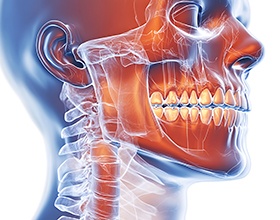
Your temporomandibular joint, also called your TMJ, consists of the hinges just in front of your ears. They control movements of your lower jaw. The TMJ is one of the most complex joints in the human body, and when it suffers damage or becomes inflamed, it can lead to a range of symptoms that together constitute TMJ disorder.
TMD may be caused by arthritis, an uneven bite, teeth grinding and clenching, injuries, or other factors.
Symptoms of TMJ Disorder
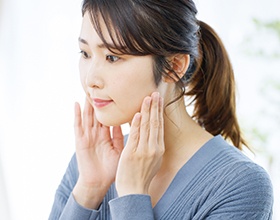
TMD can cause quite a few symptoms. Here are some of the most common:
- Tenderness and pain in and around the jaw.
- The sensation of lockjaw or limited jaw mobility.
- Popping and clicking noises when opening and closing the mouth.
- Earaches or ringing in the ears (tinnitus).
- Pain in the back, neck, and shoulders.
- Headaches and migraines.
- Noticeable changes in the way the upper and lower teeth fit together.
- Pain behind the eyes.
Types of TMJ Treatment

When you come to our practice for TMJ treatment, we will ask you about your symptoms, and Dr. Yenzer will perform a thorough examination. We may also take some X-rays. Once we gather adequate information, we can recommend your next steps.
We might advise you to try some home remedies, such as modifying your diet and using heat/cold therapy. Such measures can provide temporary relief. We may also advise you to invest in professional therapies, which can provide longer-lasting results.
Occlusal Splint
An occlusal splint is a custom oral device that resembles a mouthguard. You wear it at night so it places a barrier between the upper and lower teeth; it prevents teeth grinding. It can also help the jaw and facial muscles to relax, which can greatly reduce the pain and discomfort of TMD.
Equilibration/Occlusal Adjustment
TMD is sometimes the result of minor discrepancies in how the upper and lower teeth fit together. Dr. Yenzer might fix such issues by modifying your restorations (such as crowns or fillings) or carefully and minimally reshaping your enamel. This can result in a more harmonious bite and reduced strain on your TMJ.
BOTOX for TMJ Treatment
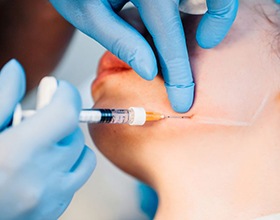
When you think of BOTOX, your mind may automatically go to its cosmetic applications. Indeed, it is an effective wrinkle treatment. But it also has some impressive therapeutic applications. In fact, it is an effective way to reduce the pain and discomfort of TMJ disorder. Here at Yenzer Family Dental of Chesterfield, Dr. Monestro is certified by the American Academy of Facial Esthetics to inject botulinum toxin (BOTOX) for both cosmetic and TMJ treatment purposes.
What Is BOTOX?
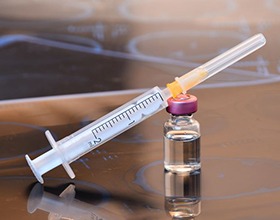
BOTOX is the brand name of a diluted form of botulinum toxin. When it is strategically injected into the facial muscles, it limits their ability to move. In cosmetic settings, this allows for the skin to take on a smoother, more youthful appearance. When used as part of TMJ treatment, this can greatly reduce the strain on overworked facial muscles. In turn, you are likely to experience significant relief from pain and other TMD symptoms.
BOTOX injections usually take less than 30 minutes, and you may start to notice results within a week or two. The pain relief can last for several months at a time.
Who Is a Good Candidate for BOTOX for TMJ Treatment?
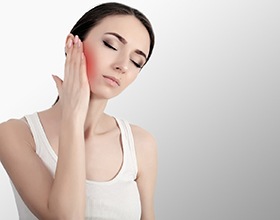
BOTOX might be able to help you find relief if you are experiencing any of the following TMD symptoms:
- Tenderness and pain in your jaw.
- Limited jaw movements or the sensation of lockjaw.
- Pain in your neck, back, and shoulders.
- Pain while chewing.
- Pain behind your eyes.
- Changes to your bite.
BOTOX may be especially helpful if your TMD is associated with bruxism (teeth grinding and clenching), jaw tension, and muscle spasms.
How Can BOTOX Treat TMJ Disorder?

When BOTOX is injected into the muscles that control jaw movement, it can force them to relax, leading to powerful relief from TMD pain and discomfort. Studies have even found that BOTOX has up to a 90% success rate in improving symptoms.
Of course, it is important to note that BOTOX is usually not a standalone treatment for TMD, since it typically addresses only symptoms rather than the underlying cause of the pain. Therefore, it is often used alongside other therapies, such as occlusal splints and occlusal adjustments. This combined approach can lead to optimal long-term results.

